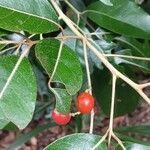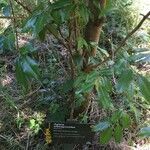Trees 1.5-15 m tall, to 30 cm d.b.h., evergreen. Bark greenish white or russet, thin, exfoliating. Young branches, petioles, rachises, and inflorescences covered with scalelike stellate rust-colored trichomes, densely brown squamate and glabrescent, or densely silvery to yellowish stellate squamate. Leaves alternate to subopposite, 10-20 cm; petiole and rachis 3-10 cm, brown squamate, covered with scalelike stellate rust-colored trichomes when young but glabrescent; leaflets (1 or)3-7, opposite to subopposite; petiolules 2-13 mm, brown squamate; leaflet blades obovate, elliptic, or oblong-elliptic, (3-)6-12(-16) × (1.5-)2.5-5.5 cm, thinly papery to leathery, both surfaces glabrous or abaxially densely yellowish squamate and adaxially densely silvery squamate but abaxially sparsely lepidote along midvein, abaxially greenish yellow when dry, adaxially lustrous, midvein abaxially prominent and adaxially slightly prominent, secondary veins 5-10 on each side of midvein, slender, and abaxially ± prominent, base cuneate to broadly cuneate and ± oblique, margin entire, apex acuminate, obtuse, or rounded. Thyrses axillary, as long as or slightly shorter than leaves, lax, covered with rust-colored or yellowish scalelike stellate trichomes or densely russet squamate. Flowers ca. 2.5 mm in diam. Pedicel ± as long as flower, covered with scalelike stellate rust-colored trichomes. Calyx ca. 0.6 mm, 5-lobed; lobes rounded, outside rust-colored or yellowish lepidote. Petals 5, oblong, 1-1.5 mm, glabrous or outside yellowish lepidote, apex rounded. Staminal tube subglobose, slightly shorter than petals, apical margin entire, undulate, or 5-lobed; anthers 5, included. Ovary ovoid, densely covered with scalelike stellate trichomes; stigma sessile. Infructescences axillary, 1-3 cm, usually with 1(-3) fruit, brown squamate; bractlets conical. Fruit indehiscent, yellowish brown when mature, subglobose, ellipsoid, or obovoid, 1-1.4 cm in diam.; persistent calyx 5-crenate, crenations triangular, brown squamate. Seeds 1(or 2) per fruit. Fl. Jun-Oct, fr. Jul-Dec.
Small tree to 20 m high, sometimes with buttresses. Indumentum of pale brown or pale orange brown peltate scales, densely covering twigs, petioles, rachis and petiolules, inflorescences and infructescences and calyces, numerous on lower leaflet surfaces and few on fruits. Leaves 4.5–22 cm long. Leaflets (1) 3–7, 2–16 cm long, 1–6 cm wide, subcoriaceous, with numerous faint or conspicuous pits on both surfaces; veins 5–10 pairs. Inflorescence 8–34 cm long. Flowers c. 2 mm long, c. 2 mm wide. Petals usually 5, white or yellow. Staminal tube subglobose, c. 1 mm long, c. 1–1.4 mm wide; aperture 0.3–0.6 mm across; anthers usually 5, just protruding through aperture. Infructescence to 12 cm long. Fruits indehiscent, subglobose, 1–2 cm long, 1.3–1.5 cm diam., red. Locules 2, each with 0 or 1 seed. Seeds partly or completely surrounded by a gelatinous white or yellow aril.
A small tree. It can be 20 m tall. It can have buttresses. The leaves are compound. They are 6-19 cm long and 7-21 cm wide. There are less than 7 leaflets. The leaflets are oval. There are scales densely covering the lower surface of the leaflet. The flowers occur in a group. They are in the axils of leaves. The flowers have 5 petals and are white or yellow. They are 2-3 mm long. The fruit is 2.5 cm long and 1.5 cm across. It is a red berry dotted with small scales. There are 1 or 2 seeds about 10 mm long.




